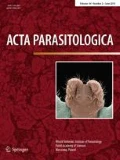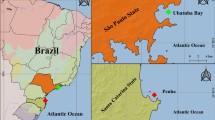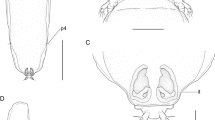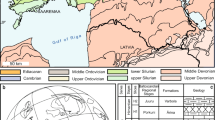Abstract
Diploproctodaeum monstrosum sp. nov. is described from Arothron stellatus and A. mappa from off Lizard Island, northern Great Barrier Reef. It differs from its congeners in having a body-length ventral scoop. Diploproctodaeum triodoni sp. nov. is described from Triodon macropterus off New Caledonia. It is distinguished by the extensive vitelline fields usually reaching to the ventral sucker and the folded scoop margins. Other related species are reported from new hosts or localities and dimensions are supplied for: Diploproctodaeum haustrum from Aluterus monoceros off New Caledonia; Diploproctodaeum arothroni from Arothron hispidus off Lizard Island and Ningaloo Reef, northern Western Australia, A. nigropunctatus off Lizard Island and Arothron manilensis off New Caledonia; Diploproctodaeum macracetabulum from Abalistes stellatus on the Swain Reefs, southern Great Barrier Reef and off New Caledonia; Diploproctodaeum momoaafata from Ostracion cubicus off Lizard Island; Diploproctodaeum rutellum from Platax teira off Heron Island, southern Great Barrier Reef; Diploproctodaeoides longipygum from Abalistes stellatus on the Swain Reefs and off New Caledonia; Diplocreadium tsontso from Balistoides conspicillum off Heron Island; Bianium arabicum from Lagocephalus sceleratus off New Caledonia. Attention is drawn to apparent convergent evolution in the body form of several families of trematodes infecting tetraodontids and especially species of Arothron.
Résumé
Diploproctodaeum monstrosum sp. nov. est décrit de Arothron stellatus et A. mappa de Lizard Island, nord de la Grande Barrière de Corail. L’espèce diffère de ses congénères par sa cuillère ventrale aussi longue que le corps. Diploproctodaeum triodoni sp. nov. est décrit de Triodon macropterus de Nouvelle-Calédonie. L’espèce est caractérisée par ses champs vitellins très développés atteignant généralement la ventouse ventrale, et par les bords plissés de la cuillère. D’autres espèces proches sont signalées de nouveaux hôtes ou localités, et leurs dimensions sont fournies: Diploproctodaeum haustrum de Aluterus monoceros en Nouvelle-Calédonie; Diploproctodaeum arothroni de Arothron hispidus de Lizard Island et Ningaloo Reef, nord de l’Australie Occidentale; Diploproctodaeum macracetabulum de Abalistes stellatus des Swain Reefs, sud de la Grande Barrière de Corail et de Nouvelle-Calédonie; Diploproctodaeum momoaafata de Ostracion cubicus de Lizard Island; Diploproctodaeum rutellum de Platax teira de Heron Island, sud de la Grande Barrière de Corail; Diploproctodaeoides longipygum de Abalistes stellatus des Swain Reefs et de Nouvelle-Calédonie; Diplocreadium tsontso de Balistoides conspicillum de Heron Island; Bianium arabicum de Lagocephalus sceleratus de Nouvelle-Calédonie. L’attention est attirée sur l’évolution apparemment convergente de la forme du corps chez plusieurs familles de trématodes infectant les Tetraodontidae, spécialement les espèces d’Arothron.
Similar content being viewed by others
References
Bray R.A. 2005. Family Lepocreadiidae Odhner, 1905. In: (Eds. A. Jones, R.A. Bray and D.I. Gibson) Keys to the Trematoda. Volume 2. Wallingford, CABI Publishing and the Natural History Museum, pp. 545–602.
Bray R.A., Cribb T.H. 2003. Lepocreadiidae (Digenea) from the batfish of the genus Platax Cuvier (Teleostei: Ephippidae) from the southern Great Barrier Reef, Queensland, Australia. Systematic Parasitology, 55, 1–9. DOI: 10.1023/A:1023974022432.
Bray R.A., Cribb T.H., Barker S.C. 1996. Diploproctodaeinae (Digenea: Lepocreadiidae) from the coastal fishes of Queensland, Australia, with a review of the subfamily. Journal of Natural History, 30, 317–366. DOI: 310.1080/00222939600770191.
Bray R.A., Nahhas F.M. 1998. Diploproctodaeum arothroni n. sp. (Digenea: Lepocreadiidae) from the pufferfish Arothron hispidus (L.) (Tetraodontidae) from Suva, Fiji, with a revised key to the species of the genus. Systematic Parasitology, 40, 55–59. DOI: 10.1023/A:1005982801820.
Bray R.A., Waeschenbach A., Cribb T.H., Weedall G.D., Dyal P., Littlewood D.T.J. 2009. The phylogeny of the Lepocreadioidea (Platyhelminthes: Digenea) inferred from nuclear and mitochondrial genes: implications for their systematics and evolution. Acta Parasitologica, 54, 310–329. DOI: 10.2478/s11686-009-0045-z.
Hafeezullah M. 1970. Lepocreadid trematodes of marine fishes of India. Parasitology, 61, 345–356. DOI: 10.1017/S0031182000041196.
Hassanine R.M.E.-S. 2006. The life cycle of Diploproctodaeum arothroni Bray and Nahhas, 1998 (Digenea: Lepocreadiidae), with a comment on the parasitic castration of its molluscan intermediate host. Journal of Natural History, 40, 1211–1222. DOI: 10.1080/02678290600883767.
Liu S.-F. 2002. Two new species of lepocreadiid trematodes of marine fishes from the Taiwan Straits, China. Journal of Parasitology, 88, 563–565. DOI: 10.2307/3285449.
Machida M., Kuramochi T. 1999. Digenean trematodes from tetraodontiform fishes from Japanese and adjacent waters. Bulletin of the National Science Museum, Tokyo, Series A, Zoology, 25, 1–25.
Overstreet R.M. 1969. Digenetic trematodes of marine teleost fishes from Biscayne Bay, Florida. Tulane Studies in Zoology and Botany, 15, 119–176.
Ozaki Y. 1928. On some trematodes with anus. Japanese Journal of Zoology, 2, 5–33.
Reimer L.W. 1981. Lepocreadiidae (Digenea) aus Fischen der Kuste von Moçambique. Angewandte Parasitologie, 22, 204–212.
Sey O. 1996. Description of Bianium arabicum sp. n. (Trematoda, Lepocreadiidae) from the pufferfish, Lagocephalus lunaris (Bloch et Schneider, 1801) in Kuwait and a review of the genus Bianium Stunkard, 1930. Parasitologia Hungarica, 28, 13–20.
Shen J.-W., Tong Y.-Y. 1990. Studies on the digenetic trematodes of fishes from the Daya Bay (Trematoda). Acta Zootaxonomica Sinica, 15, 385–392 (In Chinese).
Shimazu T. 1989. Two new species of the genus Diploproctodaeum (Trematoda: Lepocreadiidae: Diploproctodaeinae), with some comments on species in the subfamily Diploproctodaeinae, from Japanese marine fishes. Zoological Science, 6, 579–588.
Shimazu T. 1994. Rare presence of ani in digeneans of the subfamily Diploproctodaeinae (Lepocreadiidae). In: Abstracts. Eighth International Congress of Parasitology, Izmir, Turkey, p. 252.
Sogandares-Bernal F., Hutton R.F. 1959. Studies on helminth parasites from the coast of Florida. III. Digenetic trematodes of marine fishes from Tampa and Boca Ciega Bays. Journal of Parasitology, 45, 337–346. DOI: 10.2307/3274511.
Author information
Authors and Affiliations
Corresponding author
Rights and permissions
About this article
Cite this article
Bray, R.A., Cribb, T.H. & Justine, JL. Diploproctodaeum spp. (Digenea, Lepocreadiidae) in Australian and New Caledonian waters including two new species from Tetraodontiformes and new records of related species. Acta Parasit. 55, 313–326 (2010). https://doi.org/10.2478/s11686-010-0049-8
Accepted:
Published:
Issue Date:
DOI: https://doi.org/10.2478/s11686-010-0049-8




